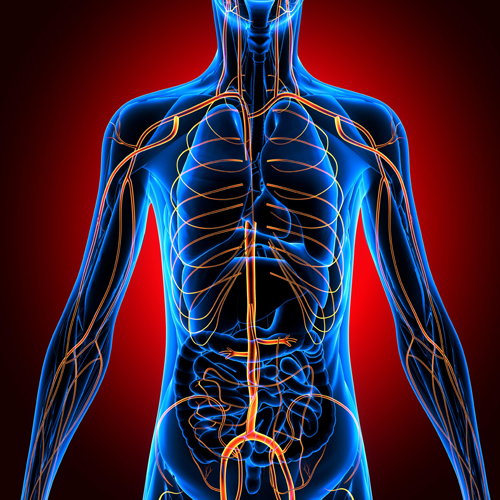Could autonomic dysfunction lead to pain in Lyme disease?

In his review of autonomic dysfunction due to infectious diseases, Artal from the Neurology Department at Raigmore Hospital in the UK, writes, “Complex regional pain syndromes [CRPS] and reflex sympathetic dystrophy with regional sympathetic hyperactivity have also been reported in some patients with Lyme disease.” [1] CRPS is characterized by considerable pain (allodynia, hyperalgesia), edema, trophic changes of the skin and muscles and sudomotor disorders.
The article, published in Clinical Autonomic Research, cites several cases [2-5] including one in which a 46-year-old patient reports increasing pain and swelling in his left foot. The pain was so significant that his leg became dysfunctional, according to the authors. “Even the slightest contact with the skin of the affected area caused the patient unbearable pain.” [2]
A patient in one of the papers cited was diagnosed with CRPS of unknown etiology until several months later when he recalled having a tick bite on his left foot. He reported having a 5 cm erythema migrans (EM) rash, which disappeared over the next two weeks. He also had stiff muscles, a swollen knee, fatigue, depression, headaches and bouts of dizziness. “On examination the patient presented with thickened upper part of his left foot which was diffusely painful to palpation. His left ankle was slightly swollen.” [2]
“The borreliosis-associated etiology of CRPS in our patient was confirmed by the positive history of untreated erythema migrans (EM), oligoarthritis, positive serological tests for B. burgdorferi with seroconversion, detection of the B. burgdorferi genome in urine by PCR, as well as by the response to antibiotic therapy.”
The patient was prescribed a 4-week course of ceftriaxone. After 2 weeks of treatment, he was able to stand on his foot without support. By the end of treatment he could walk independently, the skin of the affected foot had resumed its normal appearance and myalgia had vanished completely. The man was no longer depressed and his headaches had disappeared. According to subjective evaluation, the pain was reduced by 75% and therefore, treatment was continued with doxycycline for a another 3 weeks, explains Sibanc. [2]
The author concludes, “Although less frequent compared to inflammatory and immune-mediated disorders, infectious diseases may also affect the autonomic nervous system.” The autonomic nervous system is the part of the nervous system responsible for control of the bodily functions not consciously directed, such as breathing, the heartbeat, and digestive processes.
Artal points out that the pathogenesis of pain is unclear. However, “it is thought that complex regional pain could be either immune-mediated or due to the persistence of spirochete infection in the tissues.” [1]
References:
- Artal FJC. Infectious diseases causing autonomic dysfunction. Clin Auton Res. 2017.
- Sibanc B, Lesnicar G. Complex regional pain syndrome and lyme borreliosis: two different diseases? Infection. 2002;30(6):396-399.
- Gila L, Guerrero A, Astarloa R, Marti P, Gutierrez JM. [Reflex sympathetic dystrophy. A new manifestation of Lyme disease?]. Enferm Infecc Microbiol Clin. 1990;8(1):32-35.
- Bruckbauer HR, Preac Mursic V, Herzer P, Hofmann H. Sudeck’s atrophy in Lyme borreliosis. Infection. 1997;25(6):372-376.
- Neumann A, Schlesier M, Schneider H, Vogt A, Peter HH. Frequencies of Borrelia burgdorferi-reactive T lymphocytes in Lyme arthritis. Rheumatol Int. 1989;9(3-5):237-241.




Robbina
02/26/2018 (12:53 pm)
I suffered from Lyme Disease pretty severely for about 5 months but still went to work half a day (reduced). Just as I improved most symptoms through antibiotics, I realized I had a cluster of symptoms related to POTS and was assigned compression stockings by a neurologist. I am wondering the same. More treatment for Lyme Disease or just accept the debilitating syndrome?
Mary Lou Norman
12/16/2017 (3:52 am)
I’m CDC Lyme positive and clinical diagnosis for bartenella & babesia. Currently participating in the ‘Buffalo protocol’ for TBI, aka Traumatic Brain Injury for TBI aka Tick Borne Illness. The Dr is trying to adjust dopamine levels to increase energy levels as well as sympathetic / parasympathetic PT to ‘retrain’ autonomic cardio. I would love to learn more about what sympathetic / parasympathetic / autonomic / autoimmune issues are and how they relate to each other. Also, just how common is it to undergo concussion protocol to recover from persistent tick/internal parasite symptoms.
Dr. Daniel Cameron
12/27/2017 (10:32 pm)
You are asking all the right questions.
Chris S.
08/28/2017 (2:58 am)
Unfortunately nearly 6 years of Lyme treatment for a CDC positive case has not helped to improve my autonomic dysfunction which manifests as generalized autonomic insufficiency and leaves me with nearly no control of hypotension or heart rate and pacemaker dependent since my 20’s. How do you know when to give up on trying to improve permanently and how to differentiate between active Lyme and permanent nerve damage?
Dr. Daniel Cameron
08/28/2017 (7:50 am)
For some individuals, it can persist. A number of specialists including cardiologists and POTS specialist weigh. It can still be difficult. We need more answers.
Laura
08/21/2017 (3:28 pm)
So in this case, treating for lyme disease improved the autonomic nervous system dysfunction. Is the reverse also true? Is treating the autonomic nervous system dysfunction helpful in recovering from lyme disease?
Dr. Daniel Cameron
08/21/2017 (10:40 pm)
Good question.
Lisa king
08/21/2017 (7:14 am)
I was actually diagnosed with a form of autonomic dysfunction (P.O.T.S.) before finding out I had untreated Lyme..I believe that is what caused, triggered, of flared the P.O.T.S.